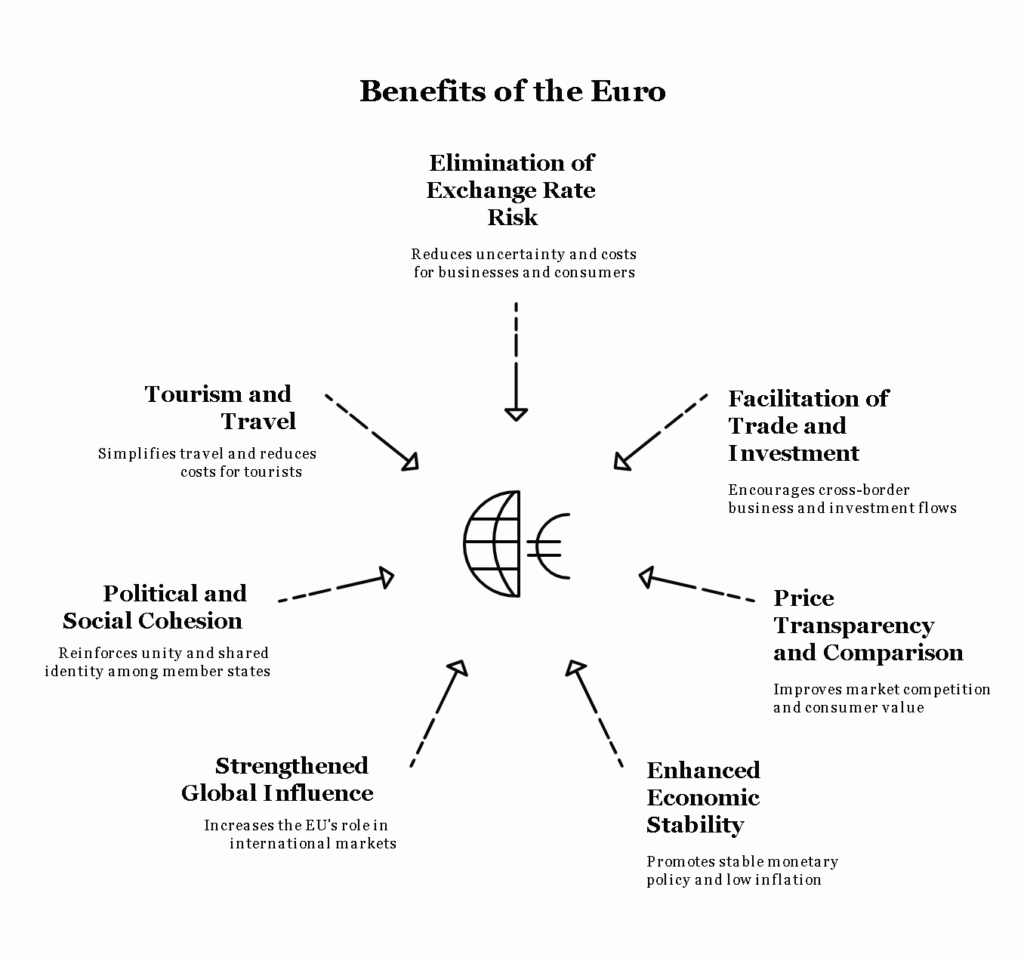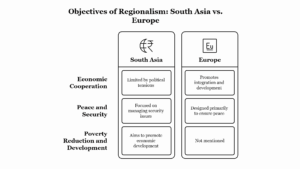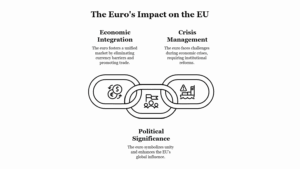The introduction of a single currency, specifically the Euro, within the European Union (EU) has been a significant step towards economic integration and political cooperation. The single currency, which was officially launched in 1999 for electronic transactions and in 2002 for physical banknotes and coins, aimed to unify the economies of the EU member states, facilitate cross-border trade, and promote political cohesion. The Eurozone—the group of EU countries that adopted the euro—comprises 20 out of the 27 EU member states as of 2025.
The benefits of the single currency system extend not only to the countries within the Eurozone but also to the EU as a whole. These advantages include economic efficiency, stability, increased investment, and strengthened global influence. Below, the key benefits of the single currency are outlined in detail.
1. Elimination of Exchange Rate Risk
One of the most direct advantages of adopting the euro is the elimination of exchange rate risk within the Eurozone. Prior to the introduction of the euro, member states of the European Economic Community (EEC) and the EU faced fluctuations in exchange rates between their national currencies. This created uncertainty for businesses and individuals involved in cross-border trade and investment.
- For businesses, the elimination of exchange rate risks reduces the cost of transactions, as companies no longer have to worry about the volatility of currency values or the need to hedge against such risks. This leads to more predictable pricing and easier budgeting for international trade and investments.
- For consumers, it removes the costs associated with currency conversion, as well as the inconvenience of carrying multiple currencies when traveling or engaging in cross-border transactions.
2. Facilitation of Trade and Investment
The single currency is a catalyst for increased trade and investment within the Eurozone. By standardizing the currency, the euro makes it easier for businesses to operate in multiple EU countries without the need for currency exchanges. This, in turn, encourages trade by lowering the costs and barriers associated with conducting business across borders.
- Cross-border trade becomes smoother because businesses do not have to factor in exchange rates, commissions for currency conversion, or the risk of currency devaluation. This fosters greater economic integration and helps small and medium-sized enterprises (SMEs) to expand their market presence across EU countries.
- Investment flows are also facilitated, as investors no longer need to worry about currency fluctuations when investing in Eurozone countries. This encourages foreign direct investment (FDI) into the region, benefiting the overall economy by promoting growth, innovation, and job creation.
3. Price Transparency and Comparison
The euro improves price transparency across the Eurozone. With a single currency, consumers can easily compare prices of goods and services across borders, leading to more competitive markets and better value for money. This drives competition, encourages innovation, and ultimately results in lower prices for consumers.
- Shoppers can compare prices for goods and services in different Eurozone countries without having to account for exchange rate differences. This transparency incentivizes businesses to keep prices competitive, benefiting consumers with better choices and improved quality.
- Price stability across the Eurozone also reduces inflationary pressures. Since price comparisons are easier and more transparent, businesses are less likely to engage in price manipulation or price disparities, leading to greater stability in the market.
4. Enhanced Economic Stability and Integration
A single currency encourages economic stability and integration among Eurozone members by removing the potential for currency-based speculation. Prior to the adoption of the euro, EU countries with weaker currencies faced frequent currency devaluations, which negatively impacted their economies and hindered growth.
- The euro offers a common monetary policy implemented by the European Central Bank (ECB). This centralized approach to monetary policy ensures that all Eurozone countries are working towards shared goals of price stability and low inflation. As a result, the euro contributes to lower interest rates and a stable economic environment across the region.
- The European Central Bank (ECB), which manages the euro, ensures the stability of the currency and sets interest rates that reflect the needs of the entire Eurozone. This centralization helps avoid the economic distortions that arise from national governments setting their own monetary policies.
5. Strengthened Global Influence
The introduction of the euro has also enhanced the global economic influence of the European Union. As one of the world’s most widely traded currencies, the euro has become a key player in international markets, second only to the U.S. dollar in terms of global reserve currency.
- The euro is used as the second most traded currency globally and is held by central banks around the world as part of their foreign exchange reserves. This provides the Eurozone with significant leverage in international economic negotiations and contributes to its global economic power.
- The euro also plays an important role in international trade. Many countries outside the EU have opted to use the euro for trade transactions, particularly with the EU. This global acceptance enhances the credibility of the EU and allows for more efficient international economic exchanges.
6. Political and Social Cohesion
The euro plays a significant role in promoting political cohesion within the European Union. By adopting a single currency, EU member states demonstrate a commitment to deeper political and economic integration. The euro symbolizes the EU’s shared identity and reinforces the notion of unity in diversity, fostering cooperation among member states.
- The common currency is a unifying factor that binds the economies and populations of Eurozone countries together. It has contributed to a sense of European citizenship, with individuals in different member states perceiving themselves as part of a larger collective European identity.
- The euro also strengthens the EU’s political influence on the global stage. As the EU grows in its external influence, the euro strengthens the political stability of the EU, providing a powerful symbol of the EU’s commitment to unity and integration.
7. Tourism and Travel
For individuals, the euro simplifies travel within the Eurozone by eliminating the need for currency exchanges, reducing associated costs, and making travel more efficient. Tourists no longer need to worry about converting their money when moving from one Eurozone country to another.
- Travel costs are reduced because individuals do not have to exchange currencies when crossing borders, leading to more affordable and predictable pricing.
- For travelers from outside the EU, the euro simplifies budgeting and spending, as they only need to deal with one currency when visiting multiple European destinations.

Conclusion
The introduction of the euro as a single currency has had far-reaching benefits for both the European Union and the broader global economy. By eliminating exchange rate risks, facilitating trade, and promoting economic integration, the euro has contributed significantly to the economic stability and growth of the EU. The currency has strengthened the EU’s position in global economic affairs and fostered political cohesion within member states. While challenges such as economic disparities among member states and fiscal crises occasionally arise, the overall impact of the single currency on the EU’s economic prosperity and global influence remains largely positive.








Leave a Reply